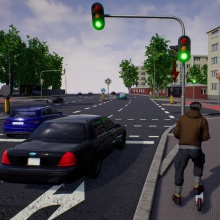Autonomous driving will come about. But how do you make it safe for each traffic situation, what transportation infrastructure will be required, and what will be the impact of future traffic models? Under the leadership of Audi AG, the SAVeNoW consortium is running a simulation on these questions using a digital twin of the urban traffic of Ingolstadt as an example. The Department of Interior Design Engineering at the Institute for Engineering Design and Industrial Design (IKTD) at the University of Stuttgart is investigating in part of the project how the design of the vehicle interior can influence traffic behavior.
If software development for autonomous driving is already a major challenge, software testing and validation will be even more so: For a variety of individual traffic situations, proof is required that the vehicle is safe. When driving on highways with their regulated traffic, such verifications are still feasible in the real world. In bustling city centers, however, this is practically impossible because of the many unpredictable traffic situations, and some tests are not an option anyway for safety reasons.
Against this background, the partners from SAVeNoW (Functional and Traffic Safety for Automated and Connected Mobility - benefits for society and ecological impact) already developed the tools and processes for a digital copy of a city in a previous project. Various road situations, traffic volumes, traffic lights, and similar things were integrated into this copy, so that scientists were able to simulate the behavior of an autonomous vehicle in these situations. This know-how will now be applied in the SAVeNoW project, using the example of the city of Ingolstadt. The project maps static elements such as roads, buildings, traffic infrastructure, and traffic rules as well as dynamic variables such as road users and general conditions such as rush hour or the weather. “Such a digital twin is of great benefit,” says Prof. Wolfram Remlinger from the IKTD, who is leading the Stuttgart subprojects of SAVeNoW. “You obtain high-quality information on road safety before even a single kilometer is tested on the real road.”
Better traffic forecasts
In addition to safety aspects, the researchers also want to use the digital twin to find solutions to issues of transport efficiency, ecology, and social acceptance. The underlying question is to what extent autonomous driving can support the political goal of getting traffic problems in cities under control.
It is an individual choice whether people use cars, motorcycles, or buses and trains, ride bicycles, walk, or use a combination of all these. It depends on factors such as travel time, availability, costs, driving / travel comfort, and perception of safety. Autonomous driving may lead to new mobility solutions, such as buses or shared cabs “on demand”, that shift the weighting of these preferences. “With the model of the digital twin we can try out how many vehicles a city will need in the future in order to meet its mobility needs, which routes will be used at which times of day, what impact this will have on traffic volume, and how the number of empty runs will develop. All of this enables improved traffic forecasts - even before the cars are built.”
The impact of vehicle interior design
People’s motivation to use autonomous vehicles and what drivers will do when there is almost no need for them to pay attention to what is happening on the road, also plays a role in the acceptance of new solutions. Do they want to talk with colleagues or use the time for a nap? On the basis of these motives, the Stuttgart scientists want to find out what types of vehicle interior and equipment vehicle users will be asking for under the new conditions. For example, new arrangements of the seats, a group table or, in contrast, glass walls between the seats would be possible.
The aim is to give citizens who are involved in the research as test subjects the opportunity to experience these options in the form of a mixed-reality model. “We want to find out what vehicle types and designs there should be in the future, but also research the processes and the readiness for change,” Remlinger concludes.
Expert Contact:
Prof. Wolfram Remlinger, University of Stuttgart, Institute for Engineering Design and Industrial Design, Head of Interior Design Engineering, Tel.+49 (0)711 685 66061 / 66055, E-Mail


